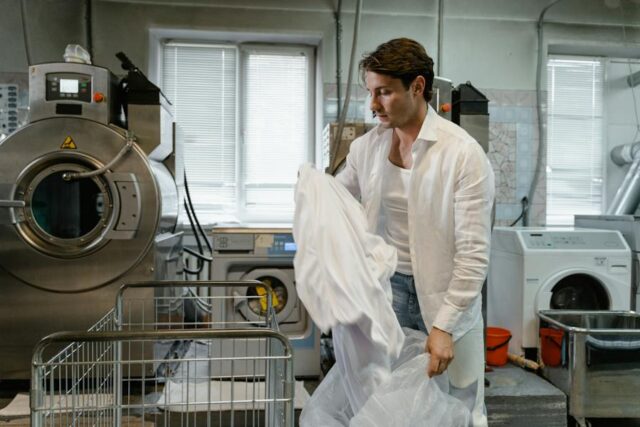A well-curated wardrobe reflects your style, personality, and investment in quality garments. From washing and storage to handling stains and maintaining fabrics, taking proactive care of your clothes can significantly extend their lifespan. This comprehensive guide will delve into vital steps for preserving your wardrobe, allowing you to enjoy your favorite pieces for years to come.
Invest In Professional Cleaning When Necessary
While many garments can be cared for at home, specific items, especially those with intricate details or made from delicate fabrics, may benefit from professional cleaning. Formal wear, silk garments, or items with complex structures, such as tailored suits, often require specialized care. According to the seasoned dry cleaning service providers from a reputable Dubai Motor City laundry, you must entrust delicate and high-value items to professionals who understand the nuances of fabric care. Professional dry cleaners use specialized techniques and gentle solvents on soft fabrics while effectively removing stains and odors.
Sorting And Preparing For Washing
The journey of proper clothes care begins with the initial steps of sorting and preparing your garments for washing. Categorize your clothes based on color, fabric type, and washing instructions. This prevents color bleeding and ensures that delicate fabrics receive the appropriate treatment. Check care labels on each garment for specific washing instructions, including recommended water temperature, cycle type, and any additional care tips. Separating clothes into whites, darks, and delicate items sets the stage for effective laundering.
Laundry is a fundamental aspect of clothes care, and adopting the proper techniques can make a substantial difference. Consider using a detergent formulated for dark clothes to maintain vibrancy for dark or bright-colored items. Cold water is generally gentler on fabrics, helping to preserve elasticity and prevent shrinkage. Turn delicate or embellished garments inside before washing to minimize friction and potential damage.
Additionally, be mindful of the washing machine load size. Overloading can lead to insufficient water and detergent distribution and ineffective cleaning. Conversely, underloading may cause garments to rub against each other excessively, causing wear and tear. Striking a balance ensures a thorough yet gentle wash for your clothes.
Handling Stains With Precision
Stains are an inevitable part of life, but addressing them promptly and correctly can prevent long-term damage to your clothes. Identify the type of stain and apply targeted stain removal methods. For oil-based stains, such as salad dressing or makeup, use a pre-treatment with dish soap or a specialized stain remover before washing. Like coffee or wine, water-based stains often respond well to cold water and a mild detergent. Avoid rubbing stains vigorously, which can spread or damage the fabric. Always test stain removers on a small, inconspicuous area first to ensure they won’t cause discoloration or damage.
Drying Techniques For Longevity
Proper drying techniques are crucial for preventing shrinkage, maintaining fabric integrity, and extending the life of your clothes. While a clothes dryer is convenient, air drying is often gentler on fabrics. Lay flat, delicate items like sweaters or lingerie to maintain their shape. Hanging clothes can lead to stretching, especially for heavier items like wet jeans.
When using a dryer, select a low heat setting to reduce the risk of shrinkage and damage. Empty the lint filter before each use to maintain optimal airflow and efficiency. Garments prone to wrinkling, like dress shirts, can benefit from removing them promptly and hanging them or laying them flat.
Mastering The Art Of Ironing
Ironing is a skill that, when done correctly, can enhance the appearance of your clothes while also preventing damage. Before ironing, check the garment’s care label to determine the appropriate temperature setting. Ironing on the wrong setting can result in scorching or shine on delicate fabrics. Use a pressing cloth to protect the material for soft fabrics, like silk or wool. Iron clothes inside out when possible, especially for items with prints or embellishments. Steam is an excellent tool for removing wrinkles without direct contact with the fabric. Use a handheld steamer or the steam function on your iron to freshen up garments without subjecting them to direct heat.
Folding And Storage Techniques
Folding and storing your clothes properly saves space, prevents wrinkles, and maintains garment shape. Knits and sweaters are best folded to avoid stretching. Use padded hangers to hold the shape of delicate items like silk blouses or dresses. Consider investing in sturdy, shaped hangers for garments that tend to lose their form, like blazers or structured jackets. When it comes to storage, keep your clothes in a cool, dry place away from direct sunlight. Use garment bags for special occasions or seasonal items. When storing off-season clothes, clean them thoroughly before packing them away to prevent stains or odors from setting.
Delicate fabrics, such as silk, cashmere, and lace, require extra attention to ensure longevity. Handwashing is often the preferred method for delicate items. Lay fragile items flat to dry on a clean towel, reshaping them as needed. For natural fibers like wool or cashmere garments, consider investing in cedarwood accessories, such as sachets or hangers. Cedarwood naturally repels moths and other pests that can damage delicate fabrics.
Regular Wardrobe Audits
Conducting regular wardrobe audits serves multiple purposes in the realm of clothes care. It allows you to assess the condition of your garments, identify items that may require repair or alteration, and declutter your wardrobe. Remove items that no longer fit, are damaged beyond repair, or have fallen out of style. Donate or repurpose these items to make room for new additions and maintain an organized and functional wardrobe.
Understanding fabric care symbols is like decoding a secret language that guides you on properly caring for your clothes. These symbols, often found on care labels, provide essential information about washing, drying, ironing, and special care instructions for each garment. Familiarize yourself with these symbols to ensure you give your clothes the care they deserve.
Caring for your clothes is a blend of art and science, requiring attention to detail, patience, and a commitment to preserving the integrity of your wardrobe. By following these vital steps—from sorting and preparing for washing to regular wardrobe audits—you can extend the life of your garments, reduce your environmental impact, and enjoy a wardrobe that stands the test of time. With a thoughtful approach to clothes care, you enhance the longevity of your favorite pieces and contribute to a sustainable and mindful approach to fashion consumption.














